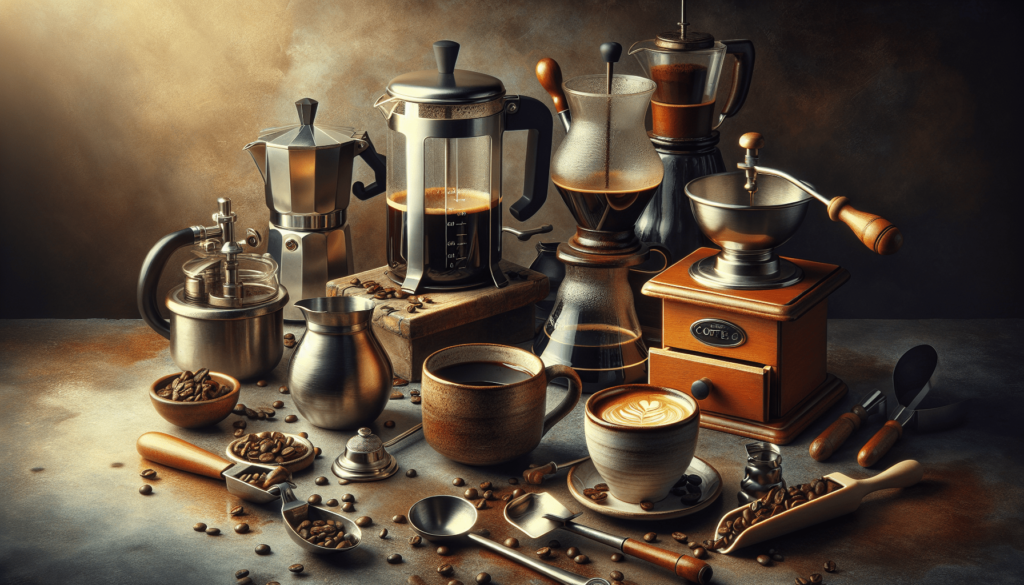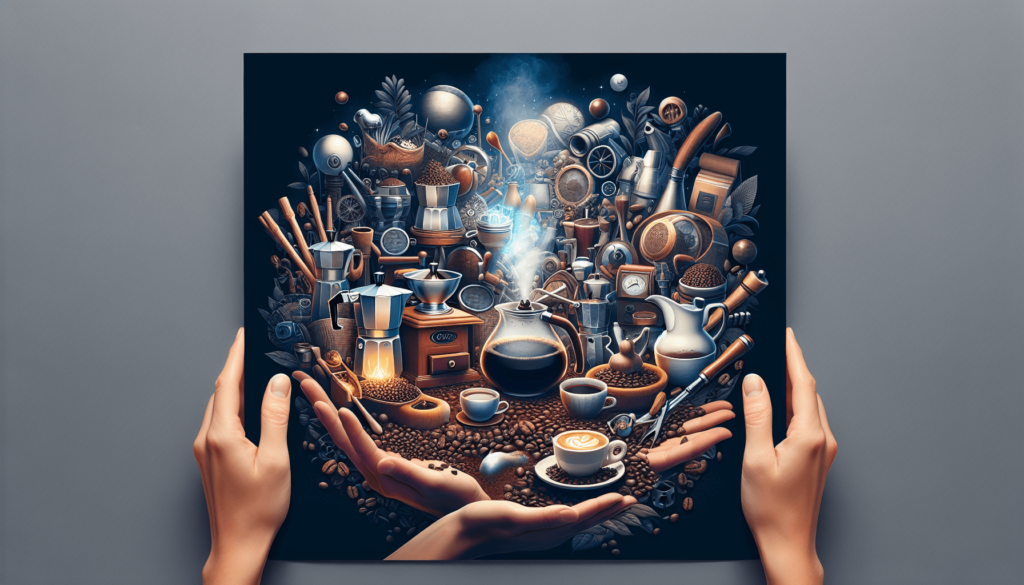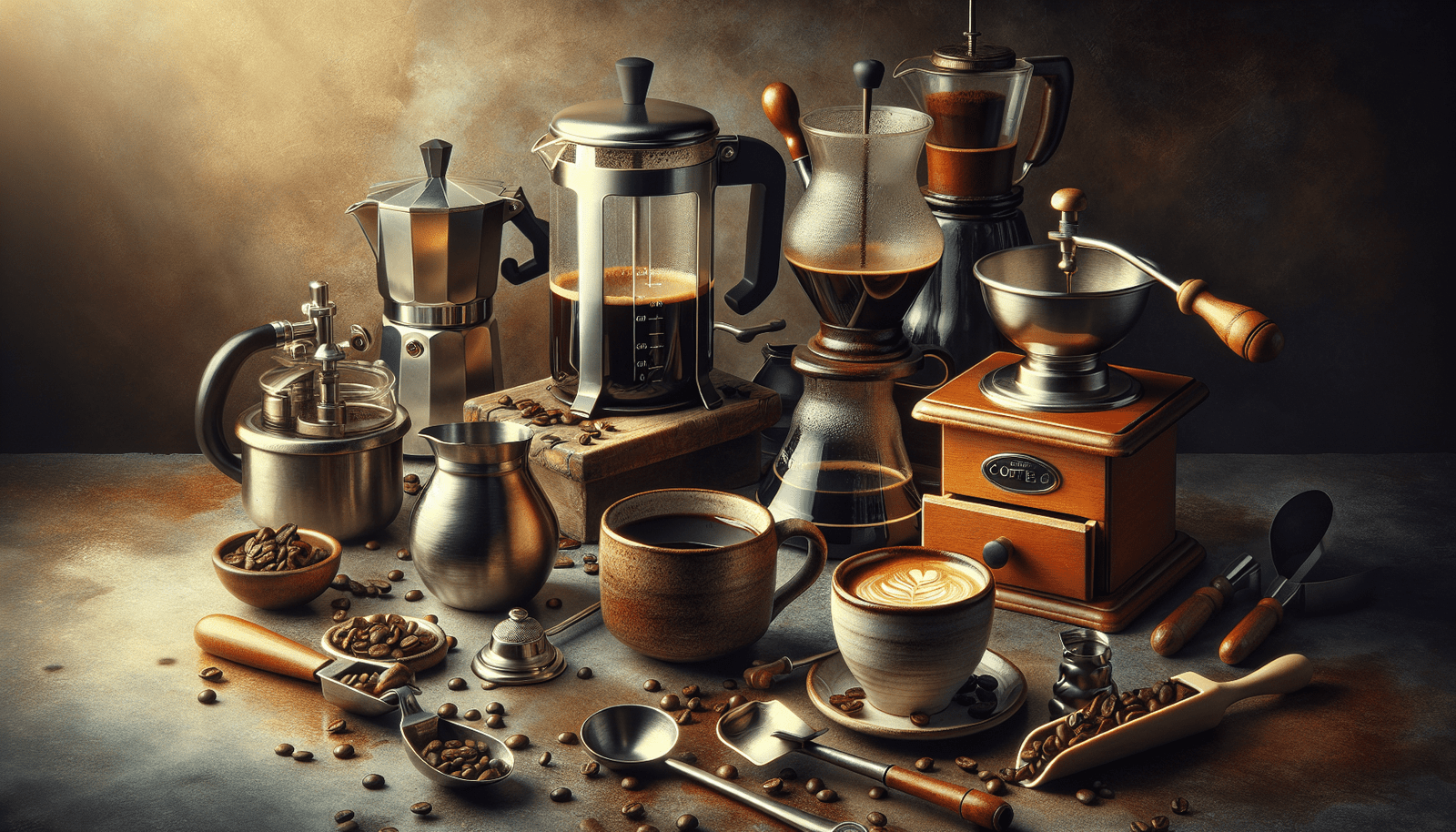Coffee lovers rejoice! If you’re a fan of the delightful aroma and rich flavors of freshly brewed coffee, then this guide is for you. In this article, we will explore the wonderful world of coffee brewing methods and accessories, giving you all the information and tips you need to elevate your coffee game. From French presses to pour-over methods, from coffee grinders to espresso machines, we’ll cover it all. So grab your favorite mug, sit back, and get ready to embark on a caffeine-filled journey.

Choosing the Right Coffee Brewing Method
Choosing the right coffee brewing method can greatly affect the taste and quality of your coffee. With so many options available, it can be overwhelming to know which one is best for you. In this guide, we will take a closer look at five popular brewing methods: Drip Coffee, French Press, Pour Over, Espresso, and AeroPress. Each method has its own unique advantages and disadvantages, so let’s dive in and explore!
Drip Coffee
Drip Coffee is perhaps the most common and familiar brewing method. It involves adding water to a reservoir and allowing it to drip through a filter and coffee grounds. This method is known for its convenience, as it allows you to brew large quantities of coffee at once. However, some argue that drip coffee may sacrifice flavor compared to other methods.
French Press
If you’re looking for a brew that delivers a bold and rich flavor, the French Press is a great option. It involves steeping coarsely ground coffee in hot water and then pressing a plunger to separate the brewed coffee from the grounds. One potential downside of the French Press is that it may contain some sediment, resulting in a slightly gritty texture.
Pour Over
Pour Over is a brewing method that gives you full control over the brewing process. It involves pouring hot water over coffee grounds placed in a filter, allowing the coffee to drip into a container below. This method requires practice to perfect the pouring technique and achieve consistent results. However, the reward is a clean and flavorful cup of coffee.
Espresso
Espresso is a concentrated and robust coffee brewing method. It involves forcing pressurized hot water through finely ground coffee at a high speed. This brewing method requires specialized equipment, such as an espresso machine, which can be quite expensive. But, for those who enjoy a strong and intense coffee experience, espresso is the way to go.
AeroPress
For those who value versatility and quick brewing, the AeroPress is an excellent choice. It uses air pressure to extract flavors from coffee grounds, producing a smooth and clean cup of coffee. The AeroPress is also portable, making it a popular choice among travelers and coffee enthusiasts on the go. However, its limited capacity may not be suitable for brewing larger quantities of coffee.
Understanding the Advantages and Disadvantages
Understanding the advantages and disadvantages of each brewing method is essential in helping you make an informed decision. Let’s take a closer look at the pros and cons of each method:
Drip Coffee: Convenience, but potentially sacrificing flavor
Drip coffee is convenient, especially if you need to brew large quantities for a group of people. It’s as simple as filling up the water reservoir, adding ground coffee to a filter, and pressing a button. However, some coffee enthusiasts argue that drip coffee machines may not extract the full flavor potential of the beans, resulting in a less nuanced cup of coffee.
French Press: Rich flavor, but may contain sediment
The French Press is renowned for its ability to produce a rich and full-bodied cup of coffee. The longer steeping time allows for deeper extraction of flavors, resulting in a more robust brew. However, the downside of this method is that it may leave behind some sediment in your cup, which some people find undesirable.
Pour Over: Full control over brewing, but requires practice
Pour Over brewing offers you complete control over the brewing process. You can control the water temperature, pour rate, and even the bloom time. This level of precision allows you to extract the coffee’s flavors to your liking. However, it does require some practice to master the pouring technique and achieve consistent results.
Espresso: Strong and concentrated, but expensive equipment
Espresso is a highly concentrated form of coffee, packed with intense flavors and aromas. The high-pressure extraction method used in espresso machines provides a unique and bold coffee experience. However, it’s important to note that espresso machines can be quite expensive, and this brewing method requires more skill and practice to master.
AeroPress: Versatile and quick, but limited capacity
The AeroPress offers a versatile and quick brewing method. It allows you to experiment with different brewing variables, such as grind size and steeping time. Additionally, the AeroPress is portable, making it a popular choice for travelers or those who want to enjoy a great cup of coffee on the go. However, the limited capacity of the AeroPress may not be ideal for brewing larger quantities of coffee.
Essential Coffee Brewing Accessories
In addition to choosing the right brewing method, having the right accessories can further enhance your coffee brewing experience. Here are some essential accessories that every coffee enthusiast should consider:
Coffee Grinder
Investing in a good quality coffee grinder is crucial for achieving a consistent grind size. Whether you prefer a burr grinder or a blade grinder, grinding your coffee beans just before brewing ensures maximum freshness and flavor extraction.
Digital Scale
A digital scale allows you to accurately measure the coffee-to-water ratio, which is essential for consistent brewing results. By weighing the coffee and water, you can adjust the ratio to suit your taste preferences and ensure a perfect cup every time.
Gooseneck Kettle
A gooseneck kettle gives you better control over the pouring technique when using brewing methods like pour over. The narrow spout allows for a slow and precise pour, helping you achieve an even extraction and a flavorful cup of coffee.
Coffee Filters
Choosing the right coffee filter is essential for optimal flavor extraction. Whether you opt for paper filters or a reusable metal filter, make sure it matches your brewing method and is of high quality to prevent any unwanted flavors from seeping into your coffee.
Coffee Beans
Last but certainly not least, the quality and freshness of your coffee beans play a significant role in the taste of your brewed coffee. Consider investing in specialty coffee beans and experiment with different origins and roast levels to find your favorite flavor profiles.
Exploring Alternative Brewing Methods
While the five brewing methods mentioned earlier are popular and widely used, there are several alternative methods that offer unique and intriguing coffee experiences. Let’s take a quick look at some of these alternative brewing methods:
Cold Brew
Cold Brew is a method that involves steeping coarsely ground coffee in cold or room temperature water for an extended period. This slow extraction process produces a smooth, low-acidity, and naturally sweet coffee concentrate that can be diluted with water or served over ice.
Siphon
The Siphon brewing method combines elements of both immersion and vacuum brewing. It uses vapor pressure and vacuum suction to extract the flavors from the coffee grounds. The result is a clean and crisp cup of coffee with vibrant flavors.
Moka Pot
The Moka Pot, also known as a stovetop espresso maker, is a popular brewing method in Italian households. It uses steam pressure to brew coffee, resulting in a concentrated and strong brew reminiscent of espresso. Moka pots are affordable, easy to use, and produce coffee with a rich flavor and a velvety crema.
Vietnamese Coffee
Vietnamese Coffee is a unique brewing method that combines dark roasted coffee with sweetened condensed milk. The coffee is brewed slowly using a traditional Vietnamese coffee filter, which drips the hot coffee onto the condensed milk, resulting in a rich and indulgent cup of coffee.
Turkish Coffee
Turkish Coffee is a method that involves boiling finely ground coffee, sugar, and water together in a cezve, a special long-handled pot. Once brewed, the coffee is poured into small cups, grounds and all. This method produces a strong and intense coffee with a thick and frothy foam known as “kaimaki.”

Comparing Roast Levels and Grinding Coarseness
When brewing coffee, it’s important to consider the roast level and grinding coarseness that best complements your chosen brewing method. Different roast levels bring out different flavors, and grind size affects how quickly the water extracts those flavors. Let’s explore these concepts further:
Light Roast: Fruity and acidic, suitable for pour over
Light roast coffee beans are roasted for a shorter duration, preserving the beans’ natural flavors. This results in a bright and acidic taste profile, often with fruity and floral notes. Light roasts are well-suited for brewing methods like pour over, as the delicate flavors can shine through.
Medium Roast: Balanced flavor, works well with most methods
Medium roast coffee is one of the most popular roast levels, offering a well-rounded flavor profile. It strikes a balance between the acidity of light roasts and the darker, bolder flavors of dark roasts. Medium roast beans are versatile and work well with most brewing methods, allowing for a satisfying cup of coffee with a good mix of flavors.
Dark Roast: Bold and smoky, ideal for espresso
Dark roast coffee is roasted for a longer duration, resulting in a more robust and intense flavor profile. The beans tend to have a dark brown color and may even exhibit an oily sheen. Dark roasts offer bold and smoky flavors, making them ideal for brewing espresso or other methods that can handle the strong taste.
Grinding Coarseness: Fine for espresso, medium for drip, coarse for French press
The coarseness of your grind plays a crucial role in how the water extracts flavors from the coffee. For espresso, a fine grind size is necessary as the water comes into contact with the coffee for a short duration. Drip brewing methods like pour over and drip coffee machines require a medium grind size to achieve a balanced extraction. Finally, the French press method benefits from a coarse grind, as the longer brewing time allows for a slower extraction process.
Tips for Achieving the Perfect Cup of Coffee
Brewing the perfect cup of coffee is an art that requires attention to detail and some experimentation. Here are some tips to help you achieve the best possible results:
Use fresh, high-quality coffee beans
The freshness and quality of your coffee beans have a significant impact on the flavor of your brew. Opt for specialty coffee beans and ensure they are stored properly in an airtight container to preserve their freshness.
Grind the beans just before brewing
To maximize flavor extraction, grind your coffee beans just before brewing. This ensures that the coffee grounds are at their freshest, allowing for optimal extraction of the flavors.
Control the water temperature
Water temperature plays a vital role in proper flavor extraction. Aim for water that is between 195°F and 205°F (90°C and 96°C) for most brewing methods. Adjusting the temperature within this range can bring out different flavors from your coffee.
Maintain the correct brew time
Different brewing methods have varying brew times, and it’s essential to follow the recommended times for each method. Over-extraction or under-extraction can greatly affect the taste and quality of your coffee.
Experiment with coffee-to-water ratio
Finding the right coffee-to-water ratio is a matter of personal preference. Start with a standard ratio, like 1:16 (1 gram of coffee per 16 grams of water), and adjust from there to suit your taste preferences.
Understanding Specialty Coffee Techniques
As you dive deeper into the world of coffee brewing, you may come across specialty coffee techniques and practices that take the coffee experience to new heights. Let’s explore some of these concepts:
Single-origin coffee
Single-origin coffee refers to coffee beans that are sourced from a specific region or even a particular farm. These beans offer unique flavor profiles that can reflect the characteristics of the region’s soil, climate, and processing methods. Exploring single-origin coffees allows you to experience the diverse range of flavors coffee has to offer.
Direct trade and fair trade practices
Direct trade and fair trade practices focus on ethical and sustainable coffee sourcing. Direct trade involves building direct relationships with coffee farmers, ensuring fair prices and promoting transparency. Fair trade certification guarantees that farmers are paid a fair price for their crops, empowering them and promoting environmentally friendly practices.
Coffee cupping and tasting notes
Coffee cupping is a professional coffee tasting technique used to evaluate the flavors and nuances of different coffees. It involves smelling and tasting coffee samples to identify specific aromas and tastes. Tasting notes, often provided by specialty coffee roasters, describe the flavor profiles of coffee and help consumers make informed choices based on their preferences.
Pairing Coffee with the Right Water
Water is an essential component of coffee brewing, and its quality can greatly impact the flavor of your brew. Here are some considerations when it comes to pairing coffee with the right water:
Understanding the impact of water on flavor
Water makes up a significant portion of your brewed coffee, so its quality and composition can greatly affect the taste. Minerals and chemicals in water can interact with coffee, either enhancing or detracting from its flavors. Experimenting with different types of water can help you fine-tune your brewing process to achieve your desired taste.
Filtering tap water for improved taste
If you’re using tap water for brewing, consider using a water filter to remove any impurities that may affect the flavor of your coffee. Filtering tap water can improve its taste and ensure a clean and crisp cup of coffee.
Using bottled or distilled water
Bottled or distilled water can be an option for those who live in areas with poor water quality or want to eliminate any potential interference from mineral content. However, it’s important to note that some minerals, like magnesium or calcium, can contribute to a rounded and balanced flavor in your brew.
Considering mineral content for espresso
Espresso brewing is particularly sensitive to water mineral content. Some minerals help extract the flavors and create a desirable crema. Espresso machines often require water with specific mineral content to achieve optimal results. Consulting the manufacturer’s recommendations or using water specifically formulated for espresso machines can help you achieve consistent and high-quality espresso shots.
Maintenance and Cleaning of Brewing Equipment
Proper maintenance and regular cleaning are essential for the longevity and performance of your coffee brewing equipment. Let’s take a look at some tips for maintaining and cleaning common brewing equipment:
Regularly clean the coffee grinder
Coffee oils can accumulate in your coffee grinder over time, affecting the flavor and performance. It’s important to clean your grinder regularly by removing any residue or build-up. Refer to the manufacturer’s instructions for the proper cleaning method for your specific grinder.
Descale coffee machines and kettles
Mineral deposits and scale can build up in coffee machines and kettles, affecting their efficiency and taste. Descaling should be done regularly, following the manufacturer’s instructions or using a descaling solution specifically formulated for coffee equipment. Regular descaling ensures optimal performance and helps extend the lifespan of your equipment.
Clean and store the French press properly
After each use, it’s important to clean the French press thoroughly to remove any coffee residue and oils. Disassemble the filter and plunger, and wash them with hot, soapy water. Allow all parts to dry completely before reassembling and storing. Proper cleaning and storage help prevent any off-flavors and maintain the longevity of your French press.
Exploring Flavor Profiles and Brewing Techniques
Coffee offers a wide range of flavors, and exploring different brewing techniques and flavor profiles can be an exciting journey of discovery. Here are some tips to help you explore and experiment with flavors:
Focus on extracting sweet flavors
Coffee, like many other foods and beverages, can have naturally occurring sweet flavors. Experiment with different brewing variables such as water temperature, brew time, and coffee-to-water ratio to enhance the sweet notes in your brew. Adjusting these variables can help you achieve a cup of coffee that is naturally sweet and well-balanced.
Adjust brewing parameters for desired taste
Don’t be afraid to tweak brewing parameters to suit your taste preferences. If you prefer a stronger brew, try increasing the coffee-to-water ratio or extending the brew time slightly. On the other hand, if you prefer a milder cup, you can adjust the grind size or decrease the coffee-to-water ratio.
Experiment with different recipes and ratios
The beauty of coffee brewing is the endless possibilities for experimentation. Try different recipes, ratios, brewing methods, and flavor profiles to expand your coffee horizons. Keep notes of your experiments, and you’ll discover your own unique preferences and brewing techniques.
In conclusion, choosing the right coffee brewing method and accessories can greatly enhance your coffee experience. Whether you prefer the convenience of drip coffee or the bold flavors of a French Press, there is a brewing method that suits your taste preferences. By understanding the advantages and disadvantages of each method, exploring alternative brewing methods, and experimenting with different flavors and brewing techniques, you’ll be well on your way to brewing the perfect cup of coffee every time. Happy brewing!

